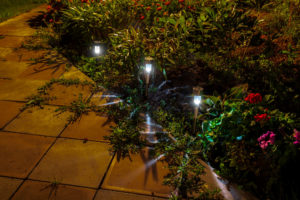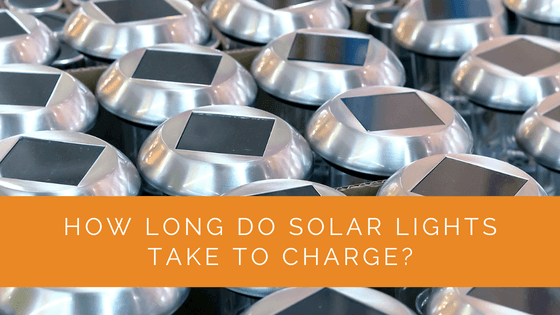With increasing electricity prices and rising carbon emissions, solar light is popular for illuminating indoor and outdoor spaces. It is independent of the electrical grid, making them environmentally friendly solutions for reducing the global carbon footprint. Moreover, they add to your curb appeal and function optimally well.
In recent times, garden lights have become popular to enhance the beauty of the outdoor landscape. These lights are seen from patios to balconies, decks, and even streets. They have two modes – warm white and color changing.
If you are considering jumping on the solar bandwagon, it is an excellent choice for you and the planet you call home.
That said, you must also be wondering about other things – How long do solar lights need to be under the sun to charge properly? What should you do in winter when the sun rarely comes out?
Don’t fret much! Instead, keep on reading to know the answers.
Contents
- 1 Key Takeaways
- 2 How Do Solar Lights Work?
- 3 How Much Time Do Solar Lights Take to Charge?
- 4 Does Location Play Any Role in the Charging of Solar Light?
- 5 How Can You Charge Your Solar Light without Sun?
- 6 Do Dirty Solar Panels Play a Role in Improving Charging Efficiency?
- 7 Expert Insights From Our Solar Panel Installers About How Long Solar Lights Take to Charge
- 8 Our Expertise in Solar Lights
- 9 The Bottom Line
Key Takeaways
- Solar lights typically take around four to eight hours to fully charge, depending on the size and type of battery used. It’s essential to follow the manufacturer’s instructions for initial charging.
- The location of your solar lights plays a significant role in their charging efficiency. Placing them in direct sunlight is ideal, but they can still charge to some extent in indirect sunlight or during winter and cloudy days.
- In situations with limited sunlight, you can use alternative light sources like incandescent bulbs or LED lights to charge your solar lights, or some solar lights even come with USB ports for easy charging. Regular cleaning of solar panels is crucial to maintain charging efficiency.
How Do Solar Lights Work?
Let’s get the basics right: how do you think solar light will illuminate a space without electricity? Well, they do use electric power, but that’s a whole different story, which goes as follows:
Solar lights utilize solar energy, but it’s more than that. They depend on the photovoltaic cells, which absorb solar energy during the daytime. Then, these cells convert solar energy into usable electric energy that powers lamps during nighttime. This electric power is usually stored in the battery of the lights. So, the more sunlight your system receives during the day, the more power it will have for use in the dark.
Solar power is a clean and renewable energy source that is available all over the world. Any point where the sun shines on the Earth is a perfect location for creating solar power. That is one good reason solar outdoor lights have gained a vast audience. It offers grid security, ensuring light in places without grid power.

How Much Time Do Solar Lights Take to Charge?
Solar lights commonly take almost four to eight hours to get fully charged. However, this time varies as per the size and type of battery used.
For instance, motion sensor light takes about six to eight hours of light to charge from the sun.
When purchasing solar lights in an outdoor space, you must pay attention to the charging time and how long they will function in the dark.
Also, remember after purchase – first, you must charge solar lights and then use them. Don’t just unbox these lights and put them to use. Most manufacturers say not to use their garden lights instantly after you open the product. You should charge them under the sun for eight hours.
However, don’t forget different manufacturers will have other specifications for charging, so be sure to go through the instructions.

Does Location Play Any Role in the Charging of Solar Light?
In outdoor places, solar lights reach full charge faster if placed directly in the sunlight. However, they will also charge in the area when sunlight indirectly falls. But as said – the more exposure to the sun, the better.
So, when choosing a place to install your solar light, you must be careful. Go out in your outdoor garden at different times throughout the day to check when the sun is scorching brightly. Also, remember that if sunlight is intense at 9 a.m., it doesn’t mean it will be prominent at 10 or 11 a.m.
Another thing to keep in mind is the different seasons. In winter, the amount of sunlight received is lower than in summer. Your solar panels do not get enough sunlight to produce electricity.
However, don’t be alarmed, as solar lights have receptors inside that are fairly strong. They can hold light irrespective of how little there is outside. This means that even on winter or dull, cloudy days, they will charge to an extent.
Thankfully, different ways exist to charge your solar system without the sun fully.

How Can You Charge Your Solar Light without Sun?
Since solar lights power through the sun, you may think they are perfect for sun-kissed areas like California, Los Angeles, and Mexico. It’s a common misconception.
If you live somewhere where the sun rarely sets out, you can still put on this light to save your pocket and the planet.
Incandescent Light
You can use an incandescent bulb to power your solar panel lights. However, using energy from artificial light to charge a supposed energy-efficient light is awkward.
However, the thought is not absurd when you use solar lights as emergency equipment indoors. So, if you need a substitute, artificial lighting will work great. Solar cells respond to both kinds of light at similar spectrums and wavelengths. Remember, it would take around 12 hours to charge.
LED Light Source
To charge your solar light, you can also use LED lights. Also, since these cover a large spectrum range, they can be more helpful than an incandescent bulb.
Power Banks
Some solar lights have an alternative charging option, such as USB ports, allowing you to plug them into power banks or sockets.

Do Dirty Solar Panels Play a Role in Improving Charging Efficiency?
You might not place importance on it, but dirt and debris are a deadly combination for your solar panel. They can not only affect charging efficiency but also provide physical harm.
If you do not clear them frequently, dirt will gather upon them, reducing charging ability, battery capacity, and lifespan. It will also reduce its performance. Warm white mode is hard to enjoy during the daytime. And let’s not even talk about the color-changing mode meant for holidays.
A thumb rule – clean and wipe your solar lights at regular intervals.
Expert Insights From Our Solar Panel Installers About How Long Solar Lights Take to Charge
Solar lights are incredibly efficient in converting sunlight into usable energy. On average, they take about four to eight hours to fully charge, depending on the type of battery and the amount of sunlight available.
Senior Solar Installer
Even on cloudy days, solar lights can still capture a significant amount of energy. It’s crucial to place them in an optimal location where they can get the most sunlight throughout the day to ensure they perform at their best.
Solar Energy Technician
Keeping your solar panels clean is essential for maintaining their efficiency. Dirt and debris can block sunlight and reduce the charging capacity, so regular cleaning is a must for optimal performance.
Solar Maintenance Specialist
Our Expertise in Solar Lights
At Solar Panels Network USA, we’re here to provide you with valuable information and support regarding solar lighting. With our experience and understanding of the solar lighting industry, our team of experts is prepared to assist you in finding the right lighting solution for your needs. Whether you’re interested in improving your outdoor spaces, conserving energy, or adopting a more sustainable approach, we’re well-equipped to help. Please feel free to contact us with any questions or inquiries.
The Bottom Line
Solar lights are going to be dominating the market for a long time. Their fanbase will only increase in the future for many reasons.
One, solar lights are cost-effective solutions to regular electricity bulbs. Second, you are minimizing your expenses and contributing to a greener planet. Third, they are easy to install with their rechargeable battery. Lastly, since they are powered by the sun, it is a source of clean energy.
The downside is that solar lights require some major time to charge. But it’s not such a major issue considering their pros and their durability and strength. Most solar light’s body is made of stainless steel, which helps stand the test of time.
In the end, solar lights are worth your bucks!
About the Author
Solar Panels Network USA stands at the forefront of solar energy solutions, driven by a team of seasoned solar engineers and energy consultants. With over decades of experience in delivering high-quality solar installations and maintenance, we are committed to promoting sustainable energy through customer-centric, tailored solutions. Our articles reflect this commitment, crafted collaboratively by experts to provide accurate, up-to-date insights into solar technology, ensuring our readers are well-informed and empowered in their solar energy decisions.

